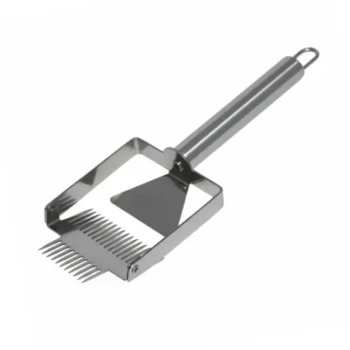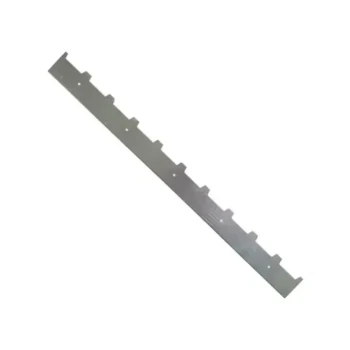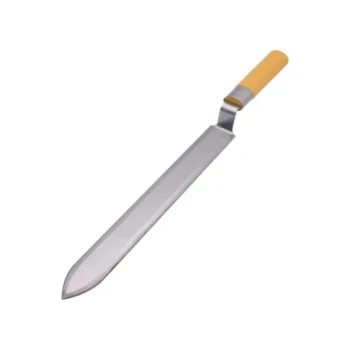The three primary methods for melting beeswax are the solar melter, the double boiler, and the crock pot or slow cooker. Each of these methods is designed around the single most important principle: using gentle, indirect heat. This approach safely liquefies the wax without overheating it, which is critical due to beeswax's flammability and sensitivity to high temperatures.
The core challenge in handling beeswax is not simply melting it, but doing so safely while preserving its quality. Your choice of method depends less on finding a "best" way and more on matching the tool to the quantity of wax you have and the level of attention you can provide.
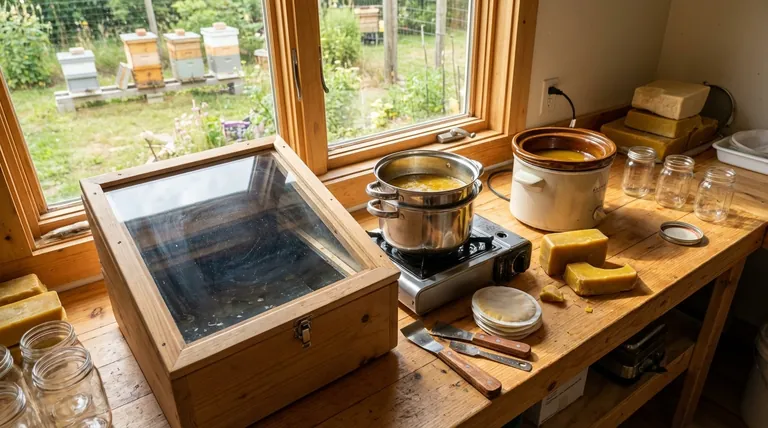
The Fundamental Principle: Why Indirect Heat is Non-Negotiable
Before choosing a method, it's essential to understand why direct heat is never recommended. Applying heat from a stove burner or open flame directly to a pot of wax is both dangerous and detrimental to the final product.
The Dangers of Direct Heat
Beeswax is a flammable material. Placing it over direct heat creates hot spots that can easily raise the wax above its flash point, creating a significant fire risk. A wax fire is incredibly dangerous and difficult to extinguish.
Preserving Wax Quality
Beyond safety, high heat damages the beeswax itself. Overheating can scorch the wax, darkening its color and destroying its naturally pleasant aroma. Gentle, indirect heat ensures the wax melts evenly and retains its valuable properties.
A Closer Look at the Three Core Methods
Each popular method provides a safe way to apply indirect heat. They differ in scale, speed, and the amount of active supervision they require.
The Solar Melter (The Hands-Off, High-Volume Option)
A solar melter is essentially a hot box with a glass lid that uses the sun's energy to melt wax. Raw comb or cappings are placed on a tray, and as the wax melts, it drips through a filter into a collection pan below, leaving many impurities behind.
This method is ideal for beekeepers with large quantities of raw wax to process. While slow, it is energy-free and requires minimal supervision.
The Double Boiler (The Controlled, Small-Batch Method)
This classic technique involves placing a smaller pot containing the beeswax inside a larger pot filled with simmering water. The water heats the inner pot gently and evenly, giving you precise control over the melting process.
This is the preferred method for smaller, cleaner batches of wax intended for crafts like candles or balms, as it allows for careful monitoring.
The Crock Pot (The "Set and Forget" Indoor Method)
Using a slow cooker is another excellent way to apply slow, gentle heat. For clarifying raw wax, you can add water to the crock pot along with the frozen cappings or comb. As the wax melts and later cools, impurities sink into the water layer or to the bottom of the solidified wax block.
This process can take several hours but is very low-effort. It's a great indoor alternative to a solar melter.
Understanding the Trade-offs and Safety
Choosing the right method involves balancing efficiency with safety and convenience.
Time vs. Attention
A solar melter is the slowest method but requires almost no active attention. A double boiler is much faster, often melting wax in 30-90 minutes, but it must never be left unattended. A crock pot falls in the middle, offering a slow, largely unsupervised process.
Equipment and Purity
It is highly advisable to use dedicated equipment for melting beeswax. Wax is notoriously difficult to clean from pots and utensils, and using dedicated tools prevents contaminating cookware you use for food.
The Critical Safety Rule
Regardless of the method (except a solar melter), you should remain present and attentive throughout the melting process. Gently stirring the wax ensures it heats evenly and allows you to monitor its temperature closely.
Making the Right Choice for Your Goal
Select your method based on the source of your wax and your intended outcome.
- If your primary focus is processing large quantities of raw comb from your hives: The solar melter is the most efficient tool for rendering bulk wax with minimal effort.
- If your primary focus is melting smaller, cleaner batches for crafts: The double boiler provides the speed and control needed to work with refined wax for projects like cosmetics or candles.
- If your primary focus is an easy, indoor method that aids clarification: The crock pot method, especially when used with water, is a simple and effective way to melt and clean raw wax simultaneously.
By prioritizing gentle, indirect heat, you can safely and effectively render beautiful, clean beeswax for any project.
Summary Table:
| Method | Best For | Key Feature |
|---|---|---|
| Solar Melter | High-volume, raw comb | Energy-free, hands-off processing |
| Double Boiler | Small, clean batches | Precise temperature control |
| Crock Pot | Indoor clarification | Set-and-forget, uses water to clean |
Ready to process your beeswax efficiently and safely?
HONESTBEE supplies commercial apiaries and beekeeping equipment distributors with the high-quality, durable supplies needed for every step of the process—from solar melters for large-scale rendering to precise double boilers for crafting. Our wholesale-focused operations ensure you get the reliable equipment your business depends on.
Contact HONESTBEE today to discuss your beekeeping supply needs and discover how we can support your operation.
Visual Guide
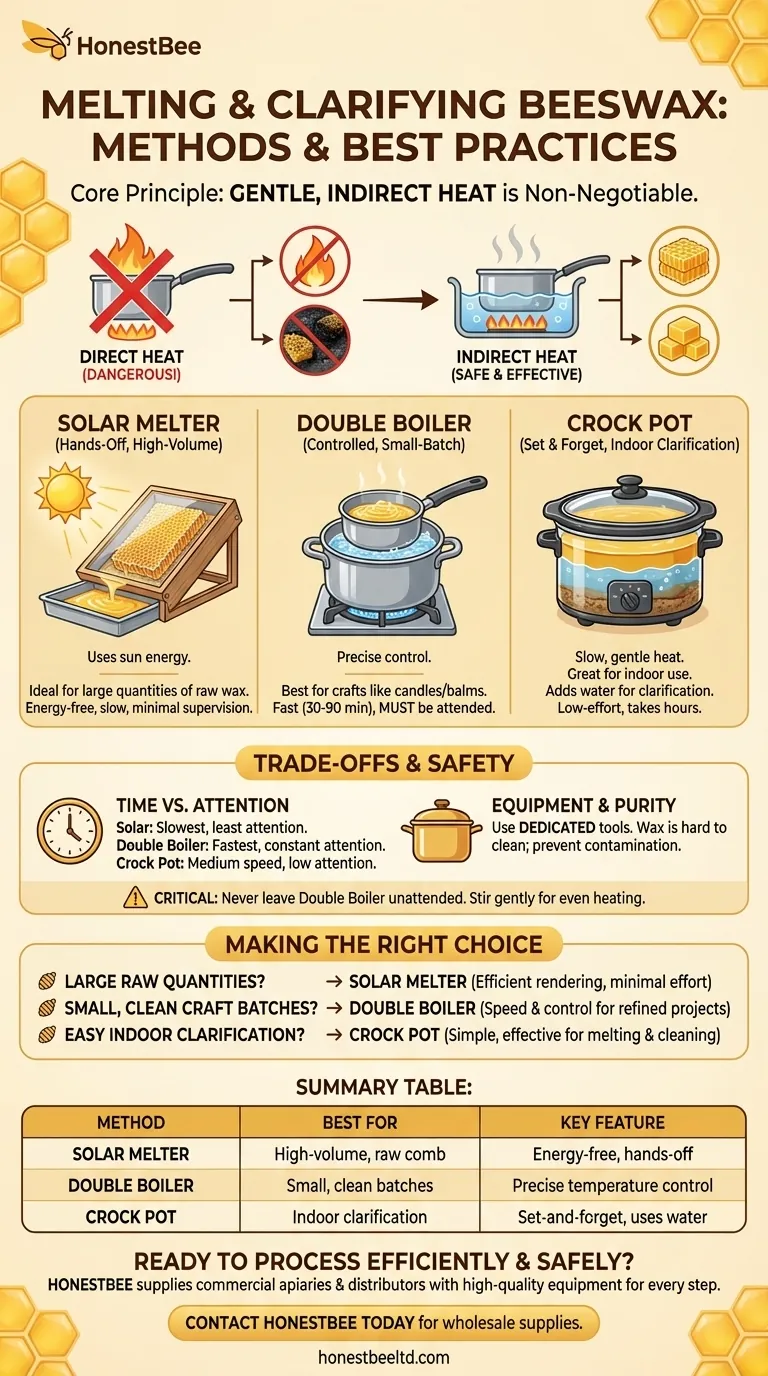
Related Products
- Professional Dual-End Stainless Steel Hive Tool for Beekeeping
- All-Stainless Steel Pivoting Honey Uncapping Fork for Beekeeping
- Heavy Duty Stainless Steel Frame Cleaner with Plastic Handle
- HONESTBEE Professional Mini J-Hook Hive Tool for Beekeeping
- Stainless Steel Dual Blade Uncapping Plane
People Also Ask
- What is a hive tool used for in beekeeping? Your Essential Guide to Hive Management
- How should beekeepers handle bees when using a hive tool? Master Calm, Deliberate Techniques
- What are the features of a regular hive tool? The Essential Multi-Tool for Every Beekeeper
- What temperature is too cold to open a beehive? Protect Your Hive from Fatal Cold Shock
- What should beginners consider when purchasing beekeeping equipment? A Guide to Essential Starter Gear





